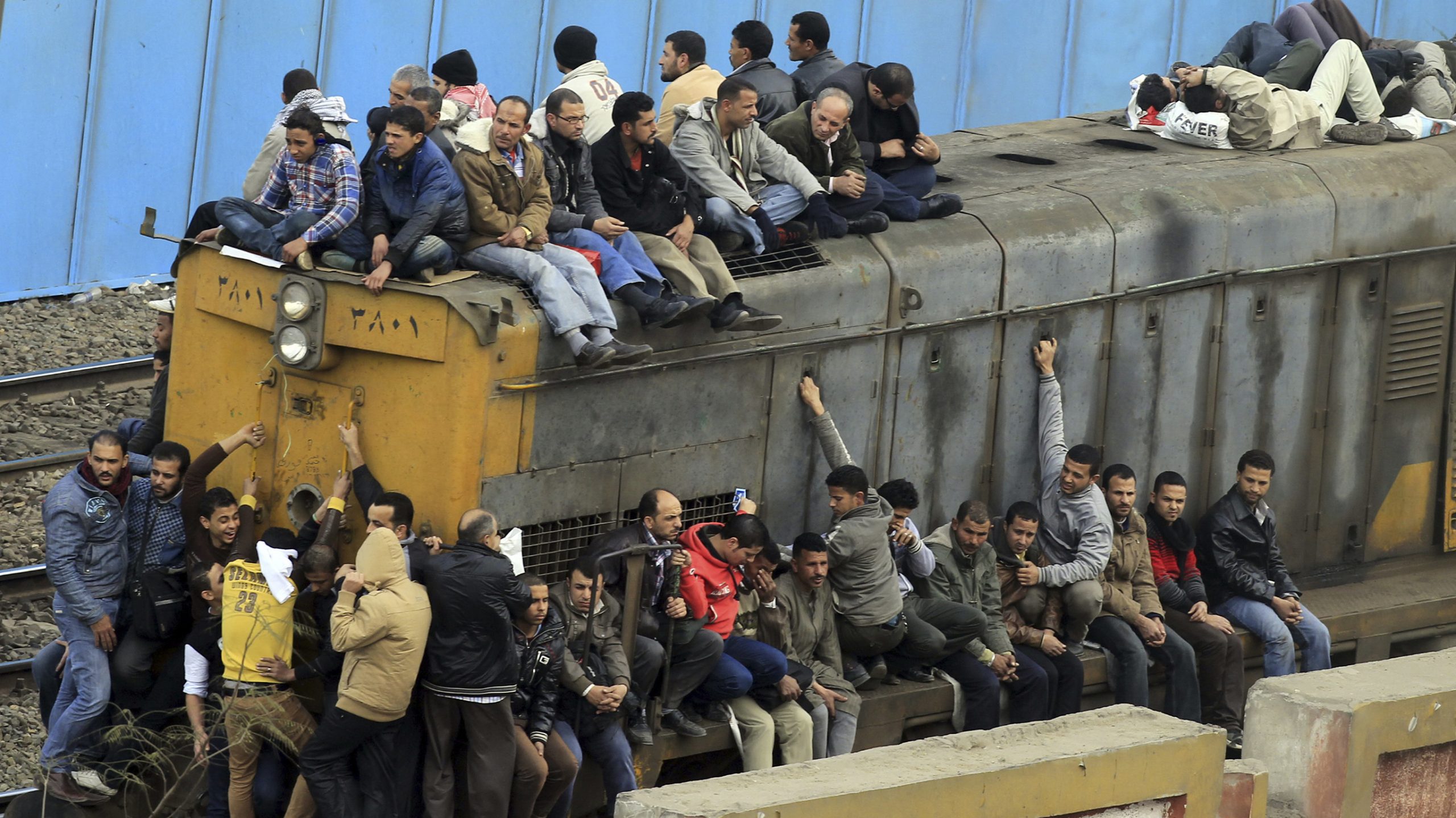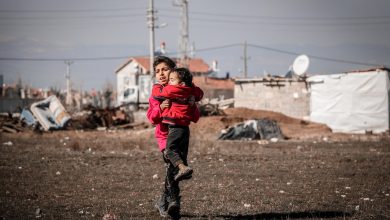Views: The Demographic Dimension of Population Growth’s Role in the Arab Uprisings

Download this article as PDF
Over the past century, the Arab region has experienced dramatic population growth, not only caused by high birth rates but also by drastically increased survival rates and life expectancy. This has resulted in the largest (and most educated) population the region has ever had. The region, too often dominated by an ageing leadership and elite, has failed – due to a combination of internal and external factors – to take advantage of this population boom, resulting in millions of marginalised and disaffected citizens. With jobs and prospects in short supply and repression in overabundance, people across the region are discontented, restive and angry. This essay explores the direct and indirect roles the region’s demographic dynamics have played in regime repression and neglect, and how this repression of the burgeoning population influenced the two main waves of Arab revolutions that swept the region, and the fierce counterrevolutions that followed. Even though the rate of population growth has slowed, the region’s population continues to expand, which will continue to affect the region’s political, social, economic and environmental landscapes.
Population Power
The Arab region has experienced unprecedented demographic growth in recent decades. This has had profound social, economic, environmental and political consequences. It played not only a significant factor in the revolutionary wave and uprisings that have rocked the region, but also in the repression that preceded and followed it.
This is not to suggest that demographic change is the only or the primary factor at play, nor is it to argue for the simplistic and deterministic theory that revolutions occur when there is a “youth bulge” or that the poor are the authors of their own destitution.
Revolutions are, after all, complicated events that occur during periods of enormous confusion. The motivating factors for which are poorly understood and disputed even by those involved in them or by those watching them closely. Revolutions occur at different places and times for an intricate web of overlapping and oft-contradictory reasons, and can be triggered by very different groups and involve a mindbogglingly diverse array of different players.
Having acknowledged the innate complexity of revolutionary movements and mass uprisings, it is my conviction – based on the evidence at hand- that the region’s demographic evolution was a major factor in sparking the mass revolts which began at the end of 2010, and in fuelling the current second wave of uprisings, though the exact role it has played differed markedly from one country to the other.
Fodder for Discontent
As a starting point, we can examine the revolutionary slogans used during protests for evidence of the role of population growth in fuelling popular discontent. “Bread”, or some similar variant, was a common rallying cry across the region, from Tunisia to Egypt and beyond, with the ongoing popular uprising in Sudan initially dubbed the ‘Bread Revolution.’
At one level, this constituted an almost literal call for bread. Food security for poor Arabs has worsened significantly in recent years. Already in 2007 and 2008, and again in 2010-2012, demonstrations and riots broke out in the Middle East and other parts of the world to protest rising food prices, which threatened to turn basic nourishment into a luxury for the poorest.
This was to a large extent due to factors external to the region, such as droughts in grain-exporting countries, rising fuel prices, growing global demand for richer diets, speculation in food commodity markets, and growing demand for biofuels.[1]
However, one factor is firmly domestic: the region’s growing inability to feed itself. Rapid population growth, coupled with water and land scarcity, not to mention the massive loss of arable land due to the dual catastrophes of global warming and urbanisation, have combined to make Arab countries among the most dependent in the world on food imports. One exception is Sudan, which possesses enough arable land to feed itself. However, this land is underutilised while being increasingly seized by foreign investors, especially in the Gulf states, for their own food security.
For example, the region imports nearly three-fifths of the wheat it consumes, with some countries importing as much as 100%.[2] Although malnutrition levels are low by the standards of developing countries, hunger levels are growing, mostly due to conflicts but also due to expanding poverty levels.[3]
Take Egypt as an example. In ancient times, its consistently large food surpluses enabled it to flourish like almost no other civilisation of the time. A century ago, the country was still able to feed itself and produce an agricultural surplus. However, since the mid-20th century, when Egypt’s population began to explode, it became increasingly dependent on food imports, especially wheat.
Today, Egypt imports a large percentage of its population’s calorific needs. This makes the country, like the wider region, extremely vulnerable to weather events, climatic conditions and geopolitical dynamics outside its own borders, in a world where the food surpluses of recent decades are shrinking while the global population continues to grow.
This leaves millions of citizens barely able to subsist in the face of rising prices and tightening supplies, especially as the welfare state continues to be dismantled with the removal of most subsidies. It is no accident that two food price shocks occurring in quick succession in an import-dependent region should play a significant role in sparking mass unrest.
Demographic Despair
The self-immolation of Mohamed Bouazizi, the symbolic act of desperation that set Tunisia on fire in 2010 and resonated with people across the region, touches on another way in which population growth set the stage for revolution.
It is true that Tunisia’s population is growing more slowly (1.1% per year) than the rest of the Arab region, largely thanks to rapidly rising levels of education, especially amongst women, and the enormous empowerment Tunisian women have experienced in recent decades, not to mention successful family planning and reproductive rights programmes.[4] Nevertheless, the population has grown considerably in recent decades. This is not just owing to birth rates but also to survival rates and life expectancy, which have risen dramatically over the past century in Tunisia and the rest of the region. A Tunisian born at the close of World War II could expect to live, on average, to only 37.[5] A Tunisian baby born today can expect to live twice as long, with life expectancy at birth standing at 74 for men and 78 for women, according to the World Health Organisation.
This has resulted in a spectacular population boom, despite Tunisia’s decades-old status as an emigrant country. Between 1921 and 1966, the population doubled to around 4.5 million.[6] Since then, it has more than doubled again, to reach the current 11 million.
Although the early years of independence were marked by fast-paced development that absorbed this rapid enlargement of the population, this eventually began to falter until, gradually, the ranks of the unemployed, underemployed and underpaid swelled to breaking point.
Naturally, rapid population growth was not the only reason why Tunisia was unable, like most of the region, to create sufficient opportunities for its citizens. Other factors included mismanagement, corruption, an ill-conceived industrialisation process, the neglect of the agricultural sector, neo-liberal reforms, as well as the rapid automation of the local and global economy. This was compounded by the pincer movement of competition from the old giants of the West, who dominate high value-added sectors, and the new giants of Asia, who dominate the more labour-intensive sectors on which the region traditionally relies.
The stagnation and even reduction in the fortunes of large swathes of the population coincided with a period in human history when material aspirations have never been higher or more visible to the average citizen, leading to a sense of relative deprivation even in cases where welfare has improved in absolute terms. Not only were the material basics of life expanding rapidly, people were being exposed to aspirational consumerism as never before, from their TVs, in films, on the internet and on the streets, as the gap between the haves and have-nots widened to become a chasm.
This made for a radioactive mix. The unemployed, who were stuck at home or sat at cafes watching their future vanish behind a pall of tobacco smoke, and the working poor who ran flat out on a treadmill that was dragging them downhill towards oblivion, had to put their aspirations on the shelves and their lives in the deep freezer, delaying – sometimes indefinitely – the greatest milestones of their lives, such as marriage, children or even their own place to live.
The Labours of Revolution
On the dawn of revolution in 2010, the proportion of the labour force out of work hovered at around 13%, according to the International Labour Organisation. The unemployment situation was considerably worse for youth (30%), the highly educated (23%) and women (19%).[7] This large idle capacity, along with the increasingly neo-liberal direction in which Tunisia was heading, led to the depression of wages for the average worker, which was reflected in the depressingly low official minimum salary of just 235 TND per month[8] (The situation in the build up to the revolution in Sudan at the end of last year was even more acute. The ranks of the jobless swelled almost threefold, from 3 million to 8 million, over a period of just seven years, with the overwhelming majority of young people out of work, according to a recent report).[9]
With the Tunisian political and business elites unable to create enough jobs for the continuously expanding labour force and unwilling to share more equitably the fruits of economic development, the path open to the regime to deal with popular discontentment was the bitter pill of repression with the added sweetener of occasional enticements and incentives.
During the Habib Bourguiba years, repression was high but the enticements were also significant: many subsidised goods, free quality education and a bloated public sector to absorb some of the surplus workforce. Under Zine El Abidine Ben Ali, the repression remained but the enticements were gradually stripped away, except for the incentive of playing the lottery of aligning oneself to the regime in the hope of getting a bite of its crony capitalist cake.
Fewer sweeteners from the state combined with bubbling resentment and discontentment from a well-educated and aspiring population led to what, in retrospect, turned out to be peak police state. The sense of fear, indignity and humiliation this caused produced the third pillar of the revolution, the quest for freedom and dignity.
Shrinking Space for the Individual
A similar dynamic prevailed in Egypt, at times more intensely. Since the end of the 19th century, the number of people living in Egypt has increased a staggering tenfold. Most of that exponential growth has been since the mid-20th century, with today’s population, which is approaching 100 million, more than five times that of Egypt’s population in 1947. In the decade between 2006 and 2016, the country’s population grew by 20 million people. Egypt’s rapidly growing population has caused it to climb up the global league table, from 20th largest population in 1950 to 15th in 2014. Egypt’s rapidly rising population is not only attributable to high birth rates but, like Tunisia, also to the dramatic decline in death rates due to the doubling of life expectancy since 1937. This population growth is reflected in Egypt’s intensifying population density, which stands at 1,137 people per square kilometre (2016), if Egypt’s vast areas of unpopulated deserts are excluded, making Egypt the 14th most densely populated country in the world.[10]
The social and environmental effects of this overcrowding are immense. There is growing awareness of the desertification caused by human-induced global warming, albeit mostly elsewhere in the world. However, there is another form of desertification that has swallowed up vast tracts of Egypt’s most fertile arable land: rapid urbanisation. By the mid-1990s already, Egypt had lost 912,000 feddans of agricultural land (over 383,000 hectares) to urbanisation.[11] Another study found that, in the quarter of a century between 1992 and 2015, 74,600 hectares of extremely fertile land in the Nile Delta alone had been destroyed by urbanisation.[12]
Overcrowding also places extreme strain on Egypt’s severely stretched water resources. In the past, Egypt, one of the driest lands on the planet which has been described as the largest oasis in the world, was the gift of the Nile because the river’s abundant waters were more than enough to keep the country fertile and fed. Today the Nile, which experts warn is dying, has become Egypt’s curse. Although the Aswan Dam has been a blessing by storing and regulating water flow, enabling the growing population to quench its thirst even during droughts, it has come with an enormous environmental price tag. The extremely fertile alluvial silt from Ethiopia, which once renewed and regenerated Egypt’s Nile valley, is trapped behind the dam. Compensating for this has required vast amounts of chemical fertilisers, which pollute the land and the river. In addition, the decades-long absence of rejuvenating silt, combined with rising sea levels caused by global warming, has caused many coastal areas to become too salinated for agriculture and is threatening the very integrity of the Nile Delta, which is slowly crumbling into the Mediterranean Sea.
With Egypt’s inhabited area smaller than Switzerland, everywhere – from its smallest towns and villages to its largest metropolises – is teeming with people. Lacking sufficient infrastructure, capacity and willpower to deal with the waste produced by so many tens of millions of humans, the quality of the air Egyptians breathe has become toxic, rubbish overflows to pollute public and natural spaces, from empty plots of land to farmland, while many agricultural canals and streams have become open sewers.
Beyond public health and environmental damage, this extreme overcrowding has serious social and psychological consequences, especially in urban areas. In Cairo, people quite literally live on top of each other. Although this has some undoubted cultural and social advantages, the streets are a constant choking confluence of smog, dust, noise and people. Egyptians cope with this overcrowding differently than, say, the Japanese. The coping mechanisms of choice in Japan are orderliness and elaborate rules for personal space and interpersonal interactions. In contrast, Egyptians tend to embrace the involuntary intimacy imposed by overcrowding by being more intimate. People are casual and sociable in public and often attempt to dissipate the tensions caused by heightened physical proximity with humour.
Nevertheless, living in overcrowded housing in an overcrowded city with constant and intense sensory stimulation is stressful, limits the individual’s personal space and makes privacy a coveted but unattainable prize, especially for the poor. There is often no reprieve or escape from the cacophony. Whereas a couple of generations ago, Cairo abounded with pleasant gardens and parks, today, there are barely any green spaces in the city and almost nowhere to escape the madding and maddening crowds. With housing beyond the means of a large proportion of young people, it has become routine for Egyptians to live with their parents until their late 20s or early 30s, with all that involves in terms of frustration and infantilisation.
Containing and neutralising the seething frustration and popular dissatisfaction required, like in Tunisia, harsh repression combined with sweeteners. However, the abandonment of this unspoken social contract in Egypt was greater than in Tunisia, as almost every area of life was privatised, including healthcare and education, while public services, especially schools and hospitals, were neglected to near death. This, combined with a rapidly growing population, meant that the middle class was withering on the vine, while the ranks of the poor and destitute were continuously reinforced.
Although Egypt’s official unemployment rate in the final quarter of 2010 was 9%, the true unemployment rate was significantly higher, not to mention the working destitute, partly because the Egyptian government counts people who do occasional casual work as being fully employed. Nevertheless, the official figures cannot distort the fact that 40% of the unemployed were university graduates and half of jobless Egyptians were between the age of 20 and 24.[13]
In the build up to the attempted revolution in 2011, Egypt had greater space for opposition, criticism and dissent than Tunisia. Despite this, Tunisia has, in a very short space of time, managed to construct a vibrant democracy. In contrast, Egypt, despite the consistently large mobilisation of protesters for an extended period of time, has slipped back into an even-more repressive form of military dictatorship, which tolerates no dissent and operates predominantly through coercion and oft extreme violence.
How did this Transpire?
Two factors loom large here: the role of the military and that of Islamists. Tunisia is among the minority of Arab countries that does not possess a large and politicised army. This served it well in the wake of Ben Ali’s departure. The Tunisian army lacked the interest, culture, means and appetite to exploit the chaos and seize the reins of power. In Egypt, the politicised army, which has enjoyed massive political influence since the Free Officers military coup in 1952, had too much to lose and perceived the popular calls for freedom as an existential threat to its parallel economy and society.
Another factor was the nature of the Islamist movement in both countries. Egypt has a large and largely uncompromising Islamist movement. In Tunisia, mainstream Islamists are more pragmatic and secularised, and less influential, than their Egyptian counterparts. This led to Tunisia’s Ennahda party engaging in the politics of compromise and consensus, which helped facilitate the country’s relatively smooth transition to democracy.
Beyond these immediate factors, demography also played a role. Not only is Tunisia less crowded than Egypt, its birth rates declined sooner and are far lower than Egypt’s. Despite Egypt’s rapid population growth, the fertility rate of individual women has declined significantly in recent decades, more than halving since 1960 to reach 3.4 in 2017.[14] Nevertheless, Egypt’s per-capita birth rate is nearly double that of Tunisia’s.
The relative stabilising of Tunisia’s population, as well as its higher level of average education and lower average levels of destitution, made the country fertile for positive change. In fact, political demographers were forecasting already in 2011, contrary to the gloomy predictions of many political pundits, that Tunisia stood a “good chance” of becoming a democracy within five years.[15] Decent leadership in civil society, trade unions and politics, as well as a symbiotic culture of consensus and compromise, managed to capitalise on these favourable conditions and delivered democracy faster than even this short estimate predicted. Of course, Tunisia is not yet out of the woods; if it fails to deliver economic welfare and social justice, the progress of recent years can be rapidly undone.
The Demography of Things to Come
The above illustrates how the dramatic demographic changes of recent decades have exercised profound direct and indirect influence on the socioeconomic and political reality of the Arab region.
Demographic change is likely to continue to play a strong role in the region’s future. Population change optimists point to the global trend of declining population growth rates and past human ingenuity to predict that we will be able to cope with the challenges of demographic expansion until we reach peak population around mid-century.[16]
However, this is not a foregone conclusion for everywhere in the world, including the Middle East. Many Arab-majority countries continue to have a population growth rate above the global average. This is partly because, in my analysis, although a growing number of people have woken up to the advantages of smaller families, the pressure from tradition, parents and religious conservatives to have larger families remains difficult to resist for many.
Moreover, the aridity of the region makes it extremely vulnerable to food supply shocks in other parts of the world, which could potentially become more frequent and prolonged due to the combined effects of global warming and the continued enlargement of the world’s population in terms of absolute numbers. Moreover, global and local economic inequalities are likely to intensify any crisis that occurs. This is compounded by cross-border competition for scarce water, such as the brewing conflict between the Nile Basin states over the river’s water resources, especially between Egypt, Sudan and Ethiopia, whose population today has overtaken that of Egypt.
Just as the potato famine in 19th-century Europe, particularly in Ireland, became a famine rather than a crisis due to the massive social and economic inequalities of the time, combined with the Malthusian propensity to blame the poor for the avarice of the rich, future food shortages could be intensified by unfair local and global distribution and consumption patterns.
Demographic and environmental change could potentially lead to a perfect storm, triggering humanitarian, political and social catastrophe in large parts of the Arab region. Alternatively, the region may continue to struggle and muddle through until its population peaks, after which welfare will improve. At present, Tunisia offers the greatest hope and model for the future of the region, as does Lebanon, which has a similar demographic dynamic to Tunisia, if the current protests trigger the right kind of momentum for change and the destabilising war in neighbouring Syria does not push this fragile and diverse country over the edge.
The most promising and hopeful possibility for the region’s demography is that increasingly empowered and aware citizens will engage in voluntary birth control, which would enable the population to even out sooner than current projections, while corrupt and repressive elites will be replaced by more enlightened political, economic and social leaders who will revive the region’s development potential by utilising its relatively young and talented populations for the greater collective and individual good of all concerned.
[1] United Nations Department of Economic and Social Affairs (2011), The global social crisis: Report on the world social situation, ‘Chapter 4: The global food crises’, (New York: UN)
[2] FAO and UN (2012), The grain chain: Food security and managing wheat imports in Arab countries (Washington: UN)
[3] Regional overview of food security and nutrition 2018 (2019) (Accra: FAO).
[4] The Overpopulation Project (July 2019), ‘The first population policies implemented in Africa: the case of Tunisia’, accessed 26 November 2019, https://overpopulation-project.com/the-first-population-policies-implemented-in-africa-the-case-of-tunisia
[5] Clark, John (1969), ‘Population Policies and Dynamics in Tunisia’, The Journal of Developing Areas, Vol. 4, No. 1, October 1969, pp. 45-58, Tennessee State University.
[6] Clark, John (1969), ‘Population Policies and Dynamics in Tunisia’, The Journal of Developing Areas, Vol. 4, No. 1, October 1969, pp. 45-58, Tennessee State University.
[7] ‘Unemployment, total (% of total labor force) (modeled ILO estimate) – Tunisia’, World Bank, accessed 19 November 2019, https://data.worldbank.org/indicator/SL.UEM.TOTL.ZS?locations=TN
[8] Ministère des Affaires Sociale, de la Solidarité et des Tunisien a l’Etranger (2010), ‘Décret No 2010-1746 du 18 juillet 2010’.
[9] Seifyazal Babekir (2019), ‘Skyrocketing unemployment ails Sudan’, Asharq al-Awsat, accessed accesses 26 November 2019, https://aawsat.com/english/home/article/1886561/skyrocketing-unemployment-ails-sudan%C2%A0
[10] Osman Magued, et al. (2016), Population Situation Analysis – Egypt 2016, (Cairo: UNFPA)
[11] Mohamed Rasmy, et al. (2010), ‘A dynamic simulation model of desertification in Egypt’, The Egyptian Journal of Remote Sensing and Space Science, (Cairo: Elsevier)
[12] Taher Radwan, et al. (2019), ‘Dramatic Loss of Agricultural Land Due to Urban Expansion Threatens Food Security in the Nile Delta, Egypt’, Remote Sensing, (UK: University of Southampton)
[13] Al Ahram staff (2011), ‘Egypt’s unemployment falls to 8.92 per cent in 2010: statistics body’, Ahram Online, accessed 19 November 2019, http://english.ahram.org.eg/NewsContent/3/12/11176/Business/Economy/Egypt%E2%80%99s-unemployment-falls-to–per-cent-in–statis.aspx
[14] ‘Fertility rate, total (births per woman) – Egypt, Arab Rep.’, World Bank, accessed 20/11/2019, https://data.worldbank.org/indicator/SP.DYN.TFRT.IN?locations=EG
[15] Richard Cincotta (2011), ‘Tunisia’s shot at democracy: What demographics and recent history tell us’, New Security Beat, Wilson Centre, accessed on 22 November 2019, https://www.newsecuritybeat.org/2011/01/tunisias-shot-at-democracy-what-demographics-and-recent-history-tell-us/
[16] Fred Pearce (2010), Peoplequake (London: Penguin)
Read this post in: العربية





